Tinfoil barbs (Barbonymus schwanenfeldii) are best described as gentle giants.
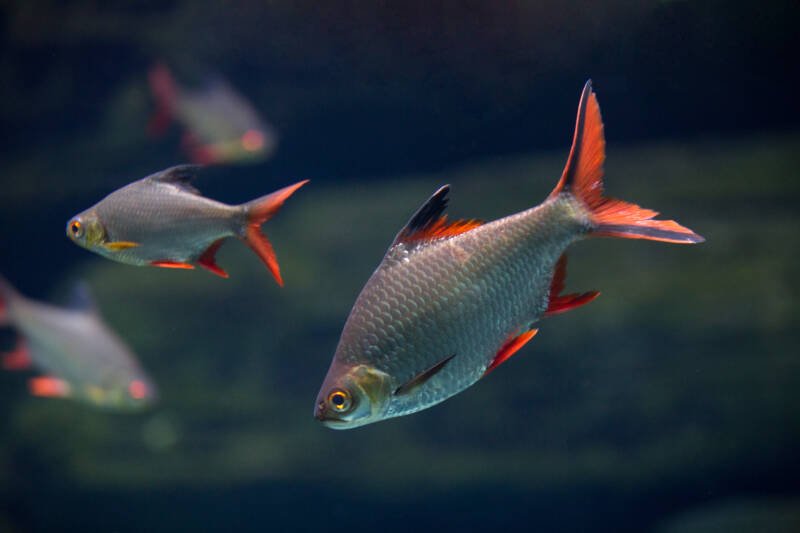
They can grow quite large even in captivity, but even so, are docile inhabitants that get along well in community tanks.
Their striking appearance and playful behavior make them a delight to watch and care for.
Though their size and gallon requirements make them a more difficult fish for beginner aquarists, their temperament and hardiness make them an excellent introduction into keeping larger fish.
In this article
Appearance and Lifespan
As is often the case with freshwater fish, the tinfoil barb’s name is quite apt.
It has large, silvery scales reminiscent of tinfoil due to their color and a metallic sheen.
Also, like tinfoil, its scales will reflect light as it swims around the aquarium.
However, tinfoil barbs can also be found in golden yellow varieties that are similarly metallic.
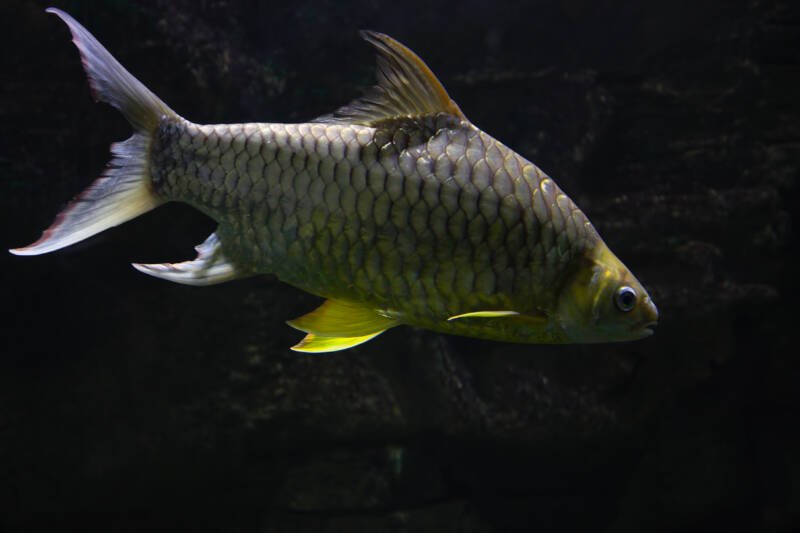
All of their fins are all translucent and have some red coloration.
Their dorsal fins are tipped in a muted red, whereas their pelvic and anal fins are almost entirely colored a bright red.
Their caudal fin, also a bright red at the tips, is split into a “v” shape to allow fast swimming.
All of their fins are short and triangular.
Tinfoil barbs can grow up to approximately 14 inches, making them a hefty aquarium addition.
In aquarium stores, they are usually sold as juveniles that are only a few inches in length.
They will quickly grow to their full size, so it’s best to start in a large tank rather than upsizing the tank as the barbs grow.
They require warm waters with lots of room to swim in, tons of water movement, and even more tinfoil barbs to be content.
With the right aquarium conditions, tinfoil barbs can live up to 10 years in captivity.
Tinfoil Barb vs. Bala Shark
Those barbs are often mistaken for bala freshwater sharks because of their coloration and size.
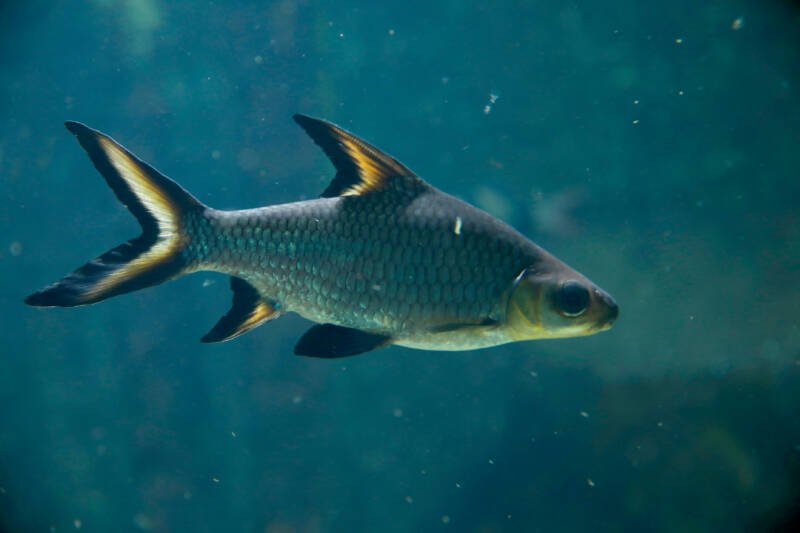
However, Bala sharks lack the distinctive redfin coloration.
Their scales are also not quite as metallic and reflective as those of the tinfoil barb.
Behavior
Tinfoil barbs are a schooling fish and must be kept with at least six other barbs.
However, they prefer as many schooling mates as possible. So the more barbs you keep, the happier and more confident they will be overall.
Tank Mates
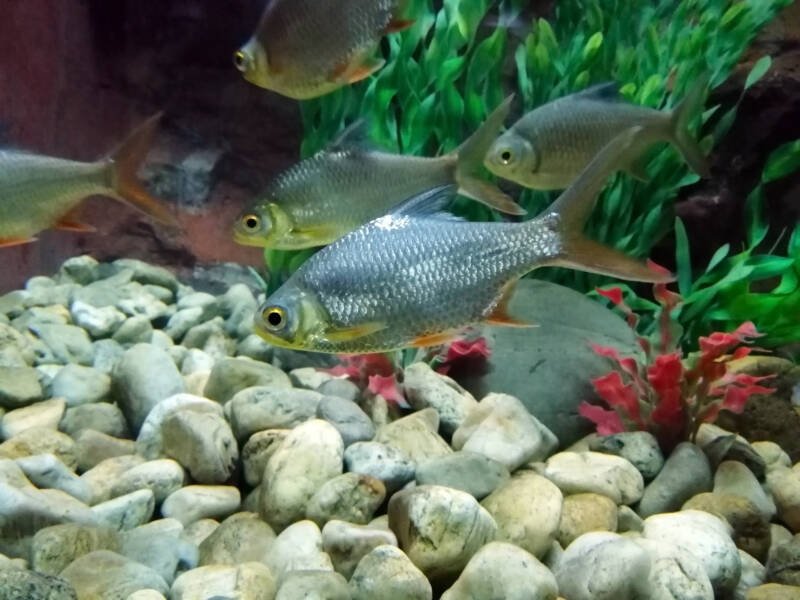
Despite their size, tinfoil barbs are a peaceful fish with an easygoing temperament.
They are very docile and will get along with almost any aquarium inhabitant.
Large and non-aggressive fish like bala sharks work best, although smaller schooling species are also often housed with tinfoil barbs.
Oscars and other non-aggressive cichlids are common tank mates.
But keep in mind that tinfoil barbs may nip at fins that are flashy and flowing, especially if the fish is slow-moving. For this reason, angelfish may not be a suitable tank mate.
They are active swimmers and are very fast. In addition to their schooling behaviors, this means that they enjoy lots of open spaces to navigate.
These barbs are highly entertaining to watch, but their antics have a downside.
Unfortunately, their activity level may disturb more leisurely fish or shy inhabitants.
Tank Setup
The tinfoil barb originated in Southeast Asia. Schools can be found in large, fast-flowing rivers that are abundant in vegetation and swimming space.
Because of their size and origin, tinfoil barbs need an aquarium with at least 70 gallons.
If you want to keep more than one barb or set up a community tank, you’ll need to double the gallon size and work up from there.
Remember to consider every factor, not just each inhabitant’s size.
A typical guide for calculating aquarium size is the “one inch per fish” rule, but this only looks at a fish’s physical size.
It fails to take into consideration bioload, temperament, and environmental needs.
Beyond investing in a large tank, it’s fairly easy to replicate the tinfoil barb’s natural habitat.
With the right equipment and setup, you’ll be cycled and ready to go in no time.
Equipment
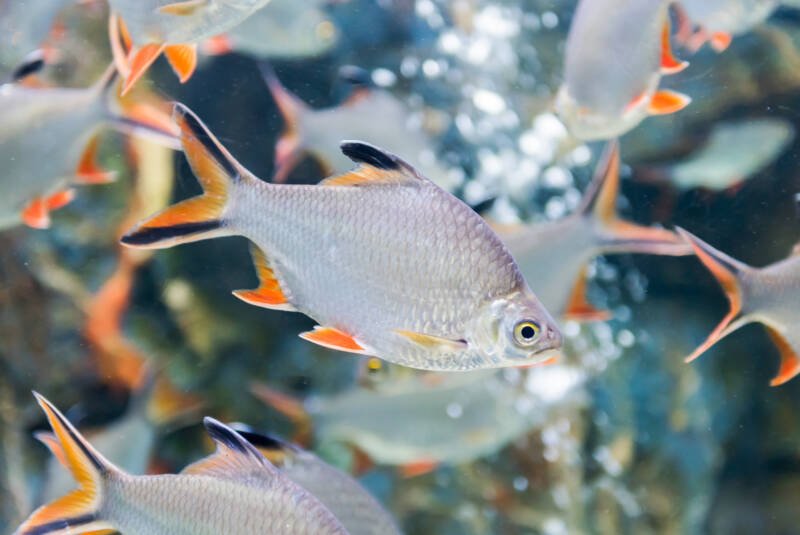
The native habitat of the tinfoil barb is easy to replicate in the aquarium. This is mainly because the water movement is the most important factor.
- Filter: You can have almost any type of filter with this fish since they enjoy strong currents. This means that even the most powerful filter will create a welcoming environment.
- Wave Maker: If you feel your filter isn’t creating enough of a current, you can also invest in a wave maker. This will create a strong water movement throughout the aquarium that the barb is sure to enjoy.
- Heater: This tropical fish will require a heater to make sure the water is warm enough to be comfortable. Because of its narrow temperature range, a thermometer is strongly recommended.
- Lid: The tinfoil barb is an active swimmer and jumper. Make sure they can’t escape and accidentally fall out. Ensure the lid is tight and invest in additional security measures, if necessary.
- Lighting: The type of lighting will largely depend on if live or fake silk plants are used. Live plants will require a plant-grade lighting system, but otherwise, almost any type of lighting will work.
- CO2 Setup: Like lighting, a CO2 setup is only truly necessary if live plants are present. If you keep live plants, CO2 is available in liquid and gas forms. Otherwise, there is no real reason to add it.
- Bubbler: Bubblers and air stones don’t necessarily create currents, but they do encourage water movement and keep the tank aerated well. They are optional pieces, not necessary.
Not all of the equipment listed above is required, but a fair bit of it is at least recommended.
Besides investing in a large aquarium, it’s really easy to get a tank ready for a tinfoil barb. The equipment is straightforward.
However, aquarists may struggle with the decision to put in live or fake silk plants.
Live plants have several benefits in the aquarium.
One of the most considerable benefits is that they more accurately recreate native habitats.
Another is that they help keep nitrate levels down and purify the water. Specific to the tinfoil barb, plant matter also makes up part of the barb’s diet.
However, live plants also have several drawbacks. The two largest cons are cost and care.
Carefully consider the benefits and drawbacks and decide if live plants are right for you.
Water Parameters
The tinfoil barb has water parameters that are easy to achieve in the aquarium.
Though there is a small range of temperatures they can stand, hobbyists have more wiggle room in terms of pH and water hardness.
- Temperature: Thrive in temperatures between 72 – 80°F. It is a very narrow range, so aquarists should closely monitor how warm the tank is.
- pH Range: This fish prefers a neutral to slightly acidic pH range of 6.0 – 7.5. Aquarists can use chemicals or natural elements to achieve this.
- Hardness: Tinfoil barbs can stand a KH that ranges from 2 – 10. Though this is not as broad as some other fish, it is still a comparatively forgiving margin.
Ammonia, nitrite, and nitrates should be kept to 0 ppm as possible.
These fish are not overly tolerant of low water quality, especially not for extended periods.
Regular weekly water changes and live plants are two ways to bring down nitrate levels consistently.
Diet and Feeding
This fish is an omnivore and will happily eat meaty foods and plant-based meals.
For meaty foods, tinfoil barbs will accept live, frozen, and freeze-dried varieties.
For plant-based foods, algae wafers, spirulina, and vegetables are all acceptable.
Caring for Tinfoil Barbs
Tinfoil barbs are docile fish whose size belies their easy care.
They are playful and avid swimmers and enjoy exploring all levels of the aquarium in their school.
Their behavior alone arrests the viewer’s eye as they zip around the tank and coast along water currents.
Combined with their beautiful coloring and shimmering appearance, tinfoil barbs are a dazzling addition to any aquarium.